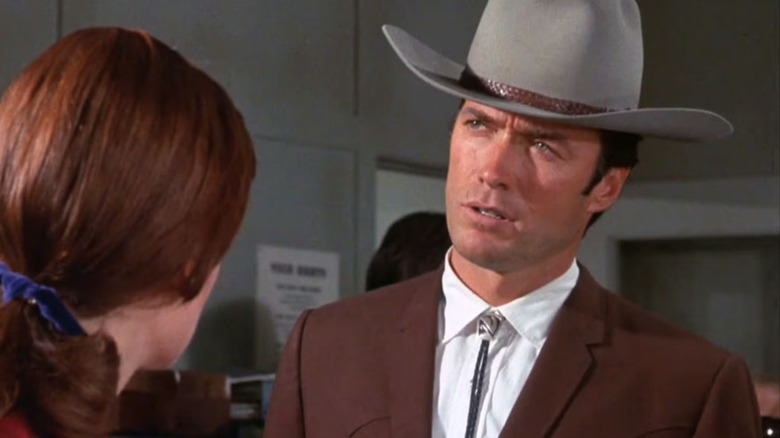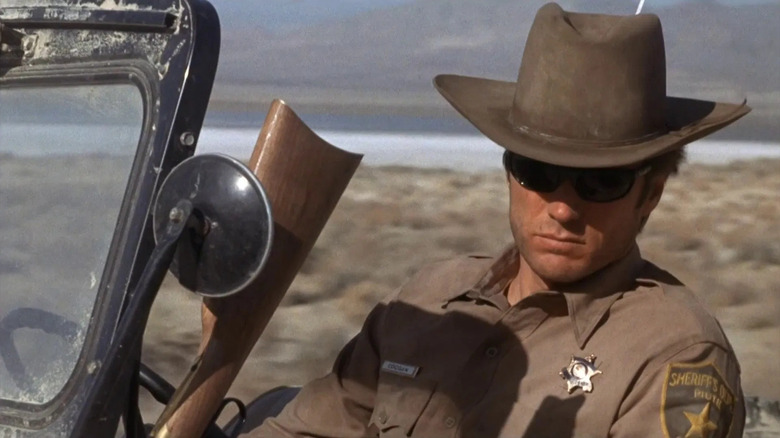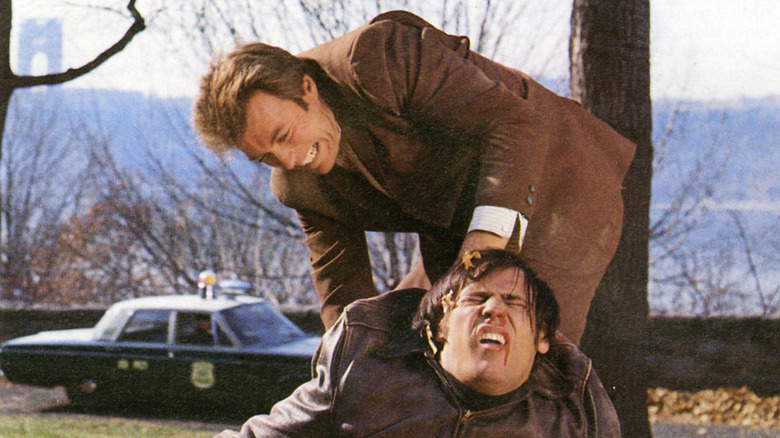One Underrated Western Merged Clint Eastwood's Two Most Famous Characters
Most Hollywood actors are lucky if they have one truly iconic character on their list of screen credits, let alone two. We might talk about Harrison Ford (Han Solo and Indiana Jones), Sylvester Stallone (Rocky and Rambo), or Keanu Reeves (Neo and John Wick), but arguably at top of the heap is Clint Eastwood with the Man With No Name and "Dirty" Harry Callahan. Not only did he make such an unforgettable impression in both roles, but those characters have also become almost synonymous with their respective genres. Can you really imagine Westerns without thinking of Clint wearing his poncho and chewing on a cheroot in Sergio Leone's "Dollars Trilogy" (or cop thrillers without picturing him squinting along the barrel of his hand cannon in "Dirty Harry")? Indeed, you can even pinpoint the moment in cinema when Eastwood's two most famous characters merged, and that movie is an underrated Western called "Coogan's Bluff."
Directed by Don Siegel, the neo-Western is the first of five movies that the veteran filmmaker made with Eastwood. Siegel had a long and sturdy career working in genre fare and was perhaps best known for helming the 1956 "Invasion of the Body Snatchers" prior to his collaborations with Hollywood's newest tough guy. Both Siegel and Eastwood were no-nonsense, forthright, and unpretentious, which made them a great pairing as the latter sought to build on the international fame he acquired by starring in Leone's Spaghetti Westerns.
"Hang 'Em High," Ted Post's pale imitation of the "Dollars" movies, made it into theaters first, but "Coogan's Bluff" was far more confident in its identity, successfully melding Western elements with a modern city-bound cop thriller. Initially conceived as a TV series by Herman Miller and Jack Laird (who had both worked on Eastwood's pre-mega-fame Western show "Rawhide") it's a great vehicle for the star's special brand of laconic badassery. Released at a time when more elegiac Westerns like "The Wild Bunch" and "Once Upon a Time in the West" were giving the classic form of the genre a mournful send-off, "Coogan's Bluff" feels almost like a rebuke against revisionism. The Wild West may have already faded into modernity by that point, but Siegel and Eastwood were taking traditional Western values into the heart of late '60s Manhattan and ready to bust some heads the old-fashioned way.
So, what happens in Coogan's Bluff?
Clint Eastwood stars in "Coogan's Bluff" as Walt Coogan, a two-fisted Deputy Sheriff from fictional Piute County, Arizona. He may drive a jeep instead of riding a horse, but he is, in many ways, a throwback to the old frontier. Unflappable and ultra-macho, he has no qualms about beating up suspects before taking them in and doesn't sweat facing down a bullet if it means getting his man. He's also a bit of a lothario, and he celebrates his latest arrest with a little nookie while his prisoner is shackled outside. His roughhouse approach exasperates his boss, who nevertheless dispatches him to New York to bring back James Ringerman (Don Stroud), a killer who has fled to the city to evade justice.
Once he's on the ground in Manhattan, Coogan couldn't look much more out of place in the gray streets of the urban jungle. Not that it matters to Walt; like Paul Hogan's "Crocodile Dundee" almost 20 years later, his no-nonsense back country methods make him more than a match for anything the city has to throw at him. Striding around in his cowboy boots, string tie, and enormous stetson, he checks into a fleabag hotel and immediately clashes with Lieutenant McElroy of the NYPD, who is played with grouchy relish by the inimitable Lee J. Cobb.
Coogan's assignment is complicated when McElroy reveals that Ringerman is currently in a hospital after overdosing on LSD and won't be released without the approval of the Supreme Court. Red tape and extra paperwork aren't the way they do things down in Arizona, and Coogan is in no mood to stick around. Instead, he tricks the hospital orderlies into handing Ringerman over to him (the "bluff" in the title), but the gamble goes badly awry when the prisoner's friends ambush the lawman and help the killer escape. Now we enter territory familiar to "Dirty Harry" fans: Despite McElroy's warning that he holds no jurisdiction in New York, Coogan goes on a rampage through the city's hippie community to track down his target and take him home by any means necessary.
Eastwood's Man With No Name transitions into Dirty Harry
"Coogan's Bluff" is a time capsule, set during a period when flower power and the counterculture movement still had momentum as the 1960s were drawing to a close. In that sense, Eastwood's Coogan is very much a representative of The Man: Ringerman may be a violent criminal who deserves bringing to justice, but the cowboy lawman's disdain towards New York's reefer-smoking bohemian underground culture is very much a square's eye view of the scene. In short, Coogan delights in harshing everyone's buzz, beating up unwashed hippie types, and sleeping with Ringerman's girlfriend to get information on his whereabouts. Just not cool, man!
It is fascinating to see how the aloofness of Eastwood's persona in the "Dollars Trilogy" merges into something approaching Dirty Harry's level of nastiness over the course of the movie. The transition from a roaming gunslinger to a no-holds-barred lawman had already begun in the actor's previous film, "Hang 'Em High," when his character acquired a marshal's badge to aid his quest for vengeance. This time around, the sheriff's badge on Coogan's shirt positions him on the side of the law, but his approach to upholding it isn't all that far removed from the Man With No Name. By the end of the movie (when things get really violent), it becomes the kind of gritty retribution regularly doled out by Harry Callahan and his very big gun.
"Coogan's Bluff" is a comparatively light-hearted film, but it paved the way for "Dirty Harry" three years later, and there are other similarities beyond Eastwood's presence. Don Stroud's rather hapless hippie criminal foreshadows Scorpio in the latter movie (Andy Robinson's long-haired sniper with a peace sign on his belt). In that respect, both movies seem to portray the counterculture movement as something deviant and threatening to traditional American values. Interestingly, the last scene of "Coogan's Bluff" is even mirrored by the opening moments of "Dirty Harry," with a woman on a skyscraper rooftop — albeit in a far darker context. It's almost as if, with "The Beguiled" (their second collaboration) in between, Siegel and Eastwood couldn't wait to carry on from where they left off. The result would set the template for the next two decades of Hollywood cop thrillers.


